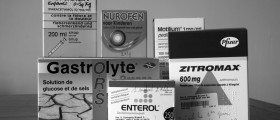
Contamination with Paracetamol, can be initiated with extremely frequent consummation or even overdosing with acetaminophen which is the name of paracetamol in the U.S. Such contamination in most cases brings the liver damage. Contamination with Paracetamol is one of the most usual cases of poisoning all over the world, and in the U.S. it’s the most usual trigger for acute liver malfunction.
First symptoms of contamination with Paracetamol may not appear in the first day after overdosing. Usually there can be symptoms, which are not common for contamination, but with outgoing illness, symptoms of liver malfunction will appear (Hepatic encephalopathy low level of sugar in blood, low blood pH, easy bleeding).
Paracetamol does not develop destruction of the liver, or hepatotoxicity. N-acetyl-p-benzoquinoneimine( NAPQI), the metabolites in Paracetamol, exhausts glutathione the livers antioxidant, harming the liver cells and by doing that, destroying the liver. Once the contamination with Paracetamol occurs, important thing to do is to eliminate Paracetamol from the system and to substitute glutathione. As the antidote that can minimize assimilation of Paracetamol and fast implementation of it is crucial, is activated charcoal (acetylcysteine). In cases of serious damage of liver transplantation of liver may be the only solution. Patients, which are treated immediately, have good chances to heal, but patients with damaged liver do not. Very important is to prevent contamination.
There are three phases in intoxication with Paracetamol. The first one starts in time of hours and causes whiteness, vomiting, sweating and vomiting. In rare cases of extremely overindulging there are possibility of metabolic acidosis and coma. The next one starts in next three days. Possibility of pain in right upper quadrant, and extremely injure of liver in this point makes biochemical markers of liver function. Hepatorenal syndrome or multiple organ dysfunction syndrome, results in this phase, in acute kidney failure. Sometimes acute kidney failure is the only symptom of contamination with Paracetamol. The third one begins after three to five days. Difficulties with massive hepatic necrosis leading to fulminant hepatic failure with complications of coagulation defects hypoglycemia, kidney failure, hepatic encephalopathy, cerebral edema, sepsis, multiple organ failure, and death are the main indicators. In case that a patient survives this phase the hepatic necrosis takes effect and the functioning of liver and functioning of kidney, naturally becomes normal and ordinary in period of couple of weeks. Dangerousness and seriousness of contamination with Paracetamol diverse conditional to the amount of toxicity and if adequate curing is performed.















,-Or-Ibuprofen-Which-Over-The-Counter-Painkiller-Should-You-Choose_f_280x120.jpg)

Your thoughts on this
Loading...